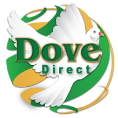Dove Direct Print and Marketing Blog, “Positioning Branded Collateral to Win”
Welcome to the Dove Direct Print and Marketing Blog. Today's post, "Positioning Branded Collateral to Win" speaks to the art of creating branded pieces that increase engagement and brand visibility. The following guidelines can help any marketer or brand produce top-notch, quality branded collateral. The technological advancements on the market today, afford easy access for content creators, graphic artists, copywriters, and creative directors to create branded collateral.
The marketing and advertising world now offers various types of collateral, from re-branding initiatives, to cross promotions, product placements, to transpromotional documents, including video creation, social media collateral and the re-purposing of content for various media outlets.
That said, there are fundamental aspects of content creation that should serve as the backbone for creating branded content that can position a brand in its best light. From start-ups to enterprise-sized organizations, the same brand content rules apply.
1. Use Correct Brand Mark Artwork
No doubt you may have come across branded collateral that appears to be flat, or off-color, or in short, a less than stellar artwork presentation. To begin with, the creative team or individual should avoid photocopying, scanning or re-drawing a version of the original mark, or original artwork. Color references for any branded mark, logo, or other collateral should align with Pantone colors. When using a brand's logo, those colors should also be a from the original logo's color assignments. Correctly matching the Pantone colors will also provide a better presentation for web-based collateral, thus presenting a seamless color presentation across all mediums.
2. Positioning the Brand Mark
Pushing creative boundaries and breaking the rules are aspects that appear throughout the marketing universe and across a range of industry sectors. Some would argue that as long as it looks good, forget the rules, as rules are broke frequently. However, it is important to understand the fundamental rules, and when the choice is made to break them, it's helpful to understand what rule is being broken or edited, and why.
The benchmark for mark/logo positioning in the print world is to place the mark at the bottom left or the top right corner. Ensure that the mark's placement is an equal distance from the two closest edges. The real range is dependent on the size and the type of the mark/logo in play.
It is also important to note the spacing around the mark/logo. There should always be enough space around the mark/logo to allow the artwork to avoid competing with any other text or artwork. Additionally, care should also be taken to keep other elements from cluttering the space around or near the mark.
Put another way, in a situation where the mark will share space with text; the general rule is to ensure that sufficient white space is equal to the largest text letter sharing the space of the mark. The mark always needs to have room to breathe and therefore can be easily seen.
3. Confirm the Correct Typeface/Font
Branded collateral is known to contain a set of fonts that appears throughout marketing communications and campaigns. It is essential to identify the correct fonts a brand is using. All too often, the creative team or a graphic designer may choose to substitute a closely aligned font in the absence of either having the original font or being able to identify the correct font. It's a good idea for brands to create a marketing brand guide consisting of fonts, color schemes, treatments, and any unique artwork for the creation of branded collateral.
Typically, another rule of thumb regarding font usage is to use fonts that come with various weights. For example, Helvetica Neue comes with fourteen different font weights, such as Condensed Bold, Condensed Black, Ultra Light, UltraLight Italic, Thin, Thin Italic, Light, Light Italic, Regular, Italic, Medium, and the list goes on.
When matching a font with a brand's typeface, it is critical to identify the correct font. When selecting a font for re-branding or a new client, naturally, the creative process dictates which fonts make sense. To that end, care should be taken to select a font that comes with multiple weights, as these weights ensure that the different degrees of impact can occur with the use of one font family.
4. Mark Background Considerations
Similar to tip number 2, Positioning the Brand Mark, is ensuring the brand mark avoids competing with background art or colors so that visual identification remains clear. The general rule of thumb is to use a white background when employing a two to four color mark. If a color background is required, then applying a lower opacity to the background aids in creating a contrast between the color mark and background color.
5. Selecting the Correct Colors
Choosing the correct colors makes all the difference. Obtaining accurate colors from the brand is critical, and that can be either with Pantone colors or hexagonal color codes found in graphic art programs such as InDesign, Illustrator, and Photoshop. Colors represent the core of the brand identity.
It is also highly recommended, that a secondary set of colors be identified to augment the primary colors, especially when working on new brand projects. Secondary colors provide added character in creative designs that help differentiate communication areas.
6. Information Pecking Order
The trick to getting folks to read branded collateral of any type is dependent on the pecking order of the information. When using text, the various text areas should be able to stand out, and follow a clear path for the reader to see and understand. Text elements also need to be easy to comprehend.
Text and graphic elements share the same space, so the combination of elements should be able to jointly co-exist in a space that presents a cohesive layout. For example, elements in a layout starting at the top right could be: 1. Publication Title, 2. Heading, 3. Intro Paragraph, 4. Main Body text, 5. Images(s), and 6. Quote or Testimonial. Layout design dictates the number of elements, and also the pecking order for reading requirements within the overall creative.
7. Photography Usage
There are various types of photography elements available today, as well as different photographic treatments. Photographic treatments should be able to either depict, support or tell a story on their own. Overall, photo images support many usages, such as explaining, educating, demonstrating needs, promoting values, stirring emotions, and creating empathy.
Depending on the goal of the content, imagery depicting the context needs to be self-explanatory. For example, if it's a picture of a famous personality, then the photograph would need to have captioning included within the image, and further, photographic choices should support the content storyline.
8. The Dynamic Curve
Often, a creative layout may contain all of the elements and procedures necessary to create an excellent presentation. However, in some cases, the elements fail to provide that pop or "wow" factor. In instances such as these, a good rule of thumb is to examine the dynamic curve.
The dynamic curve is a graphic element contained in most graphic art software. In Illustrator or Photoshop, one can use the dynamic curve to accentuate images, so they either blend better or stand out in the piece. This curve element is essential in providing the brand mark with better recognition, thus allowing the mark to stand out from the rest of the elements on the page. Keep in mind that when using the dynamic curve element, its usage should be in incremental values. Dynamic curves can be applied to multiple pieces, and particularly on front cover graphics.
The Net-Net
Creating brand collateral that elevates a brand's position takes planning and consideration of how the layout commands attention, is easily read and understood. Moreover, when following these tips, brands are ensuring that their storylines have a much better chance of positioning the brand to win. Thanks for reading "Positioning Branded Collateral to Win."
Let's have a conversation about content marketing, PUR binding, direct mail marketing strategies, printing, transactional documents, variable digital printing, brand equity and unified marketing collateral during our next Open House. We invite you to join us on Thursday, May 30, 2019, for an hour or two, anytime between 10:30 am to 3:30 pm. Let us show you how to improve your document processes to optimize your workflow, reduce your costs, and maximize your organization's printing, letter shop, and mailing capabilities. Dove Direct has an official USPS certified bureau located within our offices that will save you time and money. Moreover, if you bring us your files, we will create a demo file for you. For more information, call Carla Eubanks at 404-629-0122 or email Carla at This email address is being protected from spambots. You need JavaScript enabled to view it..
Dove Direct, your Atlanta based print and mail solutions provider offers organizations end-to-end data, printing, and mailing solutions: Data Management, Variable Digital Printing, LetterShop and Fulfillment, Fully Automated MLOCR Presort Bureau, Marketing and Production Management Support and Secure Data Life Cycle Management.
If you don't want to wait for the Open House, you can reach Dove Direct today by calling 404-629-0122 or use the contact form for Dove Direct.





